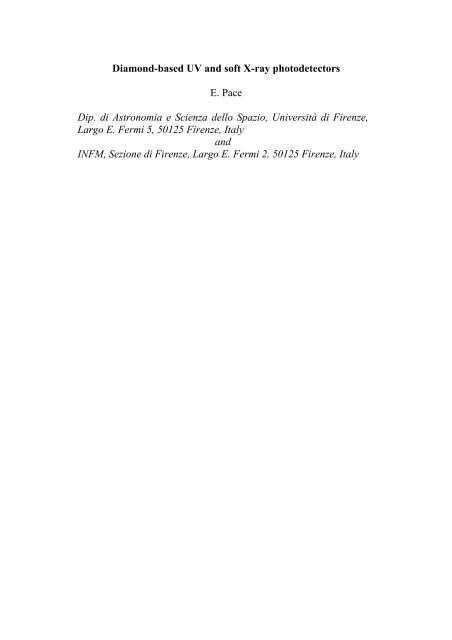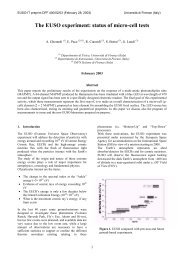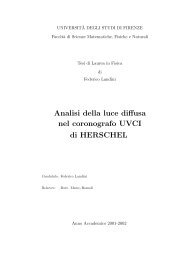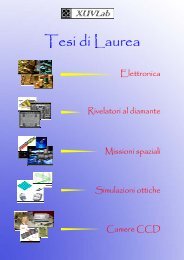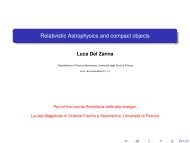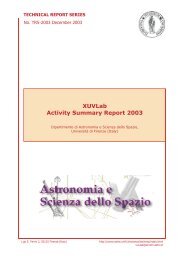Diamond-based UV and soft X-ray photodetectors E. Pace Dip. di ...
Diamond-based UV and soft X-ray photodetectors E. Pace Dip. di ...
Diamond-based UV and soft X-ray photodetectors E. Pace Dip. di ...
Create successful ePaper yourself
Turn your PDF publications into a flip-book with our unique Google optimized e-Paper software.
<strong>Diamond</strong>-<strong>based</strong> <strong>UV</strong> <strong>and</strong> <strong>soft</strong> X-<strong>ray</strong> <strong>photodetectors</strong>E. <strong>Pace</strong><strong>Dip</strong>. <strong>di</strong> Astronomia e Scienza dello Spazio, Università <strong>di</strong> Firenze,Largo E. Fermi 5, 50125 Firenze, Italy<strong>and</strong>INFM, Sezione <strong>di</strong> Firenze, Largo E. Fermi 2, 50125 Firenze, Italy
ABSTRACTOwing to its physical properties, <strong>di</strong>amond is avery promising c<strong>and</strong>idate for <strong>UV</strong> <strong>and</strong> <strong>soft</strong> X-<strong>ray</strong> photon detection. Polycrystalline <strong>di</strong>amondthick films can be grown by Chemical VaporDeposition (CVD) technique <strong>and</strong> metal<strong>di</strong>amondstructures can be produced bydepositing electric contacts on the top <strong>and</strong> backsurface. There is a considerable interest ininvestigating <strong>di</strong>amond properties in the 30-1100 nm wavelength range in order to attainhigh performance detectors having highquantum efficiency <strong>and</strong> rejection ratio forvisible photons, besides ra<strong>di</strong>ation hardness <strong>and</strong>chemical inertness. Raman spectroscopy <strong>and</strong> X-<strong>ray</strong> <strong>di</strong>ffraction are used to test the overallcrystal quality <strong>and</strong> orientation. The amount oforiented grains, i.e. the degree of texture, <strong>and</strong>their morphological quality can be thusestimated <strong>and</strong> such parameters are related to thephotoconductive performances. Photodetectorshaving ohmic <strong>and</strong> rectifying junctions <strong>and</strong> bothplanar <strong>and</strong> s<strong>and</strong>wich geometry are produced.The spectral region around the energy gap mustbe carefully investigated in order to evaluatethe selectivity to <strong>UV</strong> ra<strong>di</strong>ation <strong>and</strong> thecontribution of the impurities to conductivity.Furthermore, the quantum efficiency ismeasured in the 30-1100 nm wavelength range.This review paper describes the status of the artof <strong>di</strong>amond-<strong>based</strong> photon detectors, thetechniques employed to investigate themorphological properties <strong>and</strong> the electroopticalperformances of photoconductorsproduced in Italy <strong>and</strong> measured under <strong>UV</strong>illumination, in vacuum.INTRODUCTIONIn the last years, a considerable effort hasbeen devoted to the study <strong>and</strong> application ofnew materials for <strong>UV</strong> <strong>and</strong> X-<strong>ray</strong> photondetection. The main purpose is to solve sometechnological problems due to applications inhostile environments, or the complexity ofsensor cooling systems or the efficiency of theheat transport from the electronic devices. Sucharguments are very important for spacetechnology, but also in the scientific, industrial,telecommunication <strong>and</strong> military fields.The physical properties of <strong>di</strong>amond make ita very promising material for photon or particledetection, especially when applications in harshenvironments are required. In particular, itswide b<strong>and</strong>-gap (5.5 eV) results in a very lowleakage current <strong>and</strong> in a selective absorption oflight with wavelengths below 225 nm. Inad<strong>di</strong>tion, electronic properties <strong>and</strong> ra<strong>di</strong>ation
PROPERTIES OF DIAMOND<strong>Diamond</strong> crystal has a cubic structure,formed by one carbon atom surrounded by fourtetrahedrally (sp 3 σ-type bonds) placed nearestneighbors. This crystal structure is found alsoin silicon <strong>and</strong> germanium. The bond <strong>di</strong>stance in<strong>di</strong>amond between two nearest neighbors is0.154 nm, compared with 0.234 nm for silicon<strong>and</strong> 0.245 nm for germanium. As a result, theatomic number density in <strong>di</strong>amond is 1.77 x10 23 cm -3 , the highest of any material at normalpressure, <strong>and</strong> its mass density is 3.52 g cm -3 .The cohesive energy of <strong>di</strong>amond, the energyrequired to <strong>di</strong>sassemble a solid into itsconstituent parts, is almost twice as large asthat of silicon <strong>and</strong> germanium. This densestructure <strong>and</strong> strong bon<strong>di</strong>ng give <strong>di</strong>amondextreme hardness <strong>and</strong> wear resistance.Thermal conductivity of <strong>di</strong>amond isextremely high: at room temperature, it is fivetimes that of copper. It is able to <strong>di</strong>ssipate itsown heat or the heat generated elsewhere <strong>and</strong>can tolerate high temperature. It is one of therare materials that naturally conduct heat yetelectrically insulates. Electronically, <strong>di</strong>amond isan insulator, but can be a semiconductor bydoping it. Like silicon, <strong>di</strong>amond has an in<strong>di</strong>rectb<strong>and</strong> gap. The maximum of the valence b<strong>and</strong>lies at the center of the Brillouin zone in thereciprocal space; the lowest point of theconduction b<strong>and</strong> is near the zone boundary inthe K = (111) <strong>di</strong>rection, where the b<strong>and</strong> gap, E g ,is defined. For <strong>di</strong>amond E g = 5.470 ± 0.005 eVat 295 K.<strong>Diamond</strong> has a large breakdown electricfield (about 10 7 Vcm -1 ) <strong>and</strong> its saturationvelocity is approximately 10 7 cm s -1 . Theelectron <strong>and</strong> hole mobility is 1800 cm 2 V -1 s -1<strong>and</strong> 1200 cm 2 V -1 s -1 respectively. Table 1 listssome of the important material parameters of<strong>di</strong>amond <strong>and</strong> compares them with the silicon<strong>and</strong> germanium. The typical operatingparameters for devices <strong>based</strong> on <strong>di</strong>amond,silicon, <strong>and</strong> germanium are also included inTable 1. An interesting property of the devicesconstructed in <strong>di</strong>amond is that they attain thesaturation properties of the material at a highelectric field.Pure <strong>di</strong>amond exhibits no photonabsorption or luminescence in the visiblespectral region, at λ > 225 nm. This property isvery important for <strong>UV</strong> visible-blind<strong>photodetectors</strong>. On the other h<strong>and</strong>, photonswith λ < 225 nm are absorbed when theyimpinge on <strong>di</strong>amond. This process gives rise tothe electron excitation from the valence b<strong>and</strong> tothe conduction b<strong>and</strong> <strong>and</strong> <strong>di</strong>amond exhibitsphoto-induced electrical conductivity. It will be<strong>di</strong>scussed below in a following paragraph. Theabsorption spectra <strong>and</strong> the measured reflectance[3,15,16] are reported in Figs.1,2.Pure <strong>di</strong>amond can absorb optical ra<strong>di</strong>ationalso by the vibration of the atoms. Atoms in acrystal vibrate at characteristic frequencies ν v(phonons). If monochromatic light (usuallyfrom a laser) with frequency ν l interact withphonons in the crystal, Raman scattering canoccur. In this process photons with frequency(ν l -ν v ) (Stokes lines) <strong>and</strong> frequency (ν l +ν v )(anti-Stokes lines) are produced. The anti-Stokes line is much weaker than the Stokesline, <strong>and</strong> then the latter is normally observed.Raman spectroscopy is widely used toinvestigate the quality of CVD <strong>di</strong>amond. There,a sharp line at 1332 cm -1 reveals the presence of<strong>di</strong>amond phase. Graphite gives rise to a broaderpeak at 1580 cm -1 . The ratio of the intensities ofthese two peaks in<strong>di</strong>cates how much of eachphase is present, but is also dependent on thewavelength of excitation (v. Fig.3). The widthof the <strong>di</strong>amond line reveals how much r<strong>and</strong>omstress is present, <strong>and</strong> any <strong>di</strong>rectional stresspresent may give rise to a shift or splitting ofthe line. A very stringent test for high-quality<strong>di</strong>amond is to measure the Raman spectra withinfrared excitation (1.06 µm) rather than usingthe more conventional argon ion laser at 488nm [17].
PHOTO-INDUCED CHARGE GENERATIONIt is well known that an electromagneticwave incident on the surface of a material canbe partially reflected <strong>and</strong> partially transmitted.A simple relation can describe the intensity ofthe transmitted part, I tI t = I o (1 - R)where R is the reflectance of the material <strong>and</strong> I ois the normal incident intensity.The transmitted wave, propagating througha <strong>di</strong>electric me<strong>di</strong>um, causes transitions betweenatomic states, if its energy is as high as atomiclevel separations. As a result of photonabsorption, the intensity of the wave attenuatesas it propagates. The energy absorption leads toa decrease of the light intensity:I(x) = I t exp[-α(ν) x]α(ν) = K k(ν) / n 2where 1/α is referred to the absorption length; xis the depth from the me<strong>di</strong>um surface; ν is thelight frequency; K = ν [(µε) / c] 1/2 ; µ <strong>and</strong> ε arethe permeability <strong>and</strong> permittivity of theme<strong>di</strong>um; n <strong>and</strong> k(ν) are the optical index <strong>and</strong>the extinction coefficient, respectively. Theabsorption length is a function of photonfrequency; for example, it is about 1-2 µm (seeFig.1) in <strong>di</strong>amond for photon energy of 6 eV.When a photon excitation occurs, excesselectron-hole pairs are produced. Theprobability for excitation of a carrier by anincident photon is usually called quantumefficiency, η. Taking into account the averageenergy to form a free charge, γ, the quantumefficiency at a given photon frequency can beexpressed in terms of the previous formulas asη = hν/γ (1 - R) [1 - exp(-α(ν) x)]Two basic processes cause the electron-holerecombination [18]. The intrinsicrecombination process occurs when electrons inthe conduction b<strong>and</strong> make <strong>di</strong>rect transitions tothe vacant states in the valence b<strong>and</strong>. In theother process, electrons <strong>and</strong> holes recombinethrough interme<strong>di</strong>ate states in the b<strong>and</strong> gap.Those states, called recombination centers,exist because of structural defects or chemicalimpurities. This process is called the extrinsicrecombination process. Because theserecombination processes are independent, theeffective lifetime τ is given by1/τ = 1/τ ex + 1/τ inThe extrinsic lifetime τ ex in <strong>di</strong>amond isobserved to be of the order of 10 -8 -10 -10 s fromtransient photo-induced conductivitymeasurements. Therefore, the b<strong>and</strong>-to-b<strong>and</strong>intrinsic lifetime, τ in , which ranges from 10 -6 -1s does not play an important role in therecombination process of excess carriers whenthe material contains a considerable amount ofdefects <strong>and</strong> impurities.After illuminating <strong>di</strong>amond with pulsed <strong>UV</strong>light (λ ≤ 225 nm), the generated excesselectrons <strong>and</strong> holes move under the appliedelectric field E <strong>and</strong> induce a current pulse. Thecharge collected on electric contacts can beobtained integrating the current pulse, while thephotocurrent decay provides the carrier lifetime[19].CHEMICAL VAPOR DEPOSITION OFDIAMOND FILMSAs denoted in the introduction, CVDtechnology is used to grow <strong>di</strong>amond films. Thisapproach is <strong>based</strong> on creating a hot plasmaregion (>1500°C) near a substrate (typically at700-800°C). There, in the vapor phase, thethermal decomposition of carbon containinggases such as methane occurs.
the current saturates. The electric contact on<strong>di</strong>amond surface must be ohmic. It is <strong>di</strong>fficultto fabricate a good ohmic contact on <strong>di</strong>amonddue to its inert <strong>and</strong> wide b<strong>and</strong> gap nature. It isnecessary to somehow mo<strong>di</strong>fy the nature of aperfect <strong>di</strong>amond surface so that the voltagedrop across the contact is negligibly small ascompared to that across the active portion ofthe device. Choosing or intentionally creatingdamaged surfaces, good contacts can beaccomplished. This causes a high electric field<strong>and</strong> high recombination velocities between themetal <strong>and</strong> the <strong>di</strong>amond. This type of contacts,however, tend to be mechanically fragile <strong>and</strong>electrically very noisy. Alternative ways toproceed are ion implantation of boron in the<strong>di</strong>amond region under the metal contact or theuse of carbide forming metals such as Ti, Mo,<strong>and</strong> Ta. In the first case, although the potentialbarrier height does not change, the barrierthickness is reduced <strong>and</strong> charge-carriers on the<strong>di</strong>amond side can easily communicate with thecontact by tunneling through the barrier. Theohmic behaviour of carbide forming metalcontacts after annealing has been attributed tothe formation of carbide at the interface. Theyare evaporated onto <strong>di</strong>amond <strong>and</strong> subsequentlyannealed at elevated temperatures (typically ~400°C) to enhance the carbide formation at themetal/<strong>di</strong>amond interface. The metals are oftencapped with a thin Au layer to avoid theiroxidation.The extremely high resistivity of intrinsic<strong>di</strong>amond eliminates the need for reverse-biasedjunctions <strong>and</strong> the associated material doping tosuppress thermally generated currents. Inad<strong>di</strong>tion, the large b<strong>and</strong> gap produces anextremely reduced dark current <strong>and</strong> then verylow-level photo-generated currents can bedetected.The basic physics of charge generation <strong>and</strong>collection in photoconductor can be illustratedby assuming a uniform device with mobilecharge carriers, electron <strong>and</strong> hole, generated byincident ra<strong>di</strong>ation [21,22]. Consider a flux F o (t)of photon at a given wavelength that is incidenton a photoconductive detector. Considering thequantum efficiency, η, as defined above, thecarrier generation rate is G(t) = η F o (t). Thenumber of charges, N, is related to thegeneration rate by the following:dN /dt = G(t) – N /τFor an impulse excitation <strong>and</strong> a carrierdensity N o at t = 0,N(t) = N o exp(– t /τ)while in the steady state, when the generationrate equals the recombination rate, isN = G τ = η F o τIf an external electric field E is applied theexcited carriers move. The two types of carrierscover an average drift <strong>di</strong>stance, denoted ascollection <strong>di</strong>stance, L, that is determined bytheir drift velocity v d <strong>and</strong> lifetime τ:L = v d τ = µ E τSince electrons <strong>and</strong> holes have <strong>di</strong>fferenteffective masses (m * e, m * h) <strong>and</strong> exist in<strong>di</strong>fferent energy b<strong>and</strong>s, the values of electronmobility (µ e ) <strong>and</strong> hole mobility (µ h ) may be<strong>di</strong>fferent. In ad<strong>di</strong>tion, the electron lifetime (τ e )<strong>and</strong> hole lifetime (τ h ) may not be equal.Therefore, the collection <strong>di</strong>stance L is equal towhereL = (µ e τ e + µ h τ h ) E = µ E τµ = (µ e τ e + µ h τ h ) / τ<strong>and</strong> τ is the mobility weighed lifetime.Each one of these carriers drift under theelectric field influence at the mean velocity v d =µ(E)E giving rise to a current in the external
circuit of i = qv d / d, where d is the length of thematerial between the electrodes (Ramo-Shockley theorem [23]). The total current isthus the product of i <strong>and</strong> the number of carrierspresenti t = iN = qF o η v d τ /d = qF o η (τ /τ d ) = qF o η(L /d)where τ d = d /v d is the drift time for a carrieracross the length d, while L = vτ is the me<strong>and</strong>istance a charge moves in the detector. Thefactors (τ/τ d ) or (L /d) thus represent thefraction of the crystal length drifted by theaverage excited carrier before recombining.If the current is integrated over time, therelation between the photo-generated chargeQ ph <strong>and</strong> the collected charge Q c isQ c = Q ph (L /d) = Q ph µτE /dIf L /d >1, then all the charge Q ph will becollected <strong>and</strong> the factor (µτE /d) can beconsidered as a gain factor. If L /d 400°C) [24,25]. The <strong>di</strong>odesmanufactured on p-type CVD <strong>di</strong>amond sufferedfrom relatively large leakage currents. One wayto reduce this effect would be to place a thin,defect-free, insulating layer between the metalcontact <strong>and</strong> the <strong>di</strong>amond (MIS <strong>di</strong>ode structure).In its intrinsic state, <strong>di</strong>amond is itself aninsulator, <strong>and</strong> can be easily inserted by CVDgrowth on top of the p-type-doped substrate. Athin layer of SiO 2 (about 2 nm) has alsosuccessfully been used to reduce leakage(metal-oxide-semiconductor structure, MOS),but the I(V) characteristics of this structuredegrades as the temperature increases [26,27].The MOS structure has an advantage over theSchottky <strong>and</strong> MIS structure, since it is possibleto drive the charge carriers to the accumulationmode. Thus it is expected that the MOSstructure will allow a higher degree of freedomin terms of operation of the Schottky contact<strong>based</strong><strong>di</strong>amond devices. On the other h<strong>and</strong>, theMIS structures have an advantage in terms ofdensity of interface states <strong>and</strong> then they allow alower leakage current.In general, the electrical properties ofSchottky contacts on <strong>di</strong>amond such as barrierheights have little dependence on the materialproperties of the metals such as work functionsor electronegativity. It has been observed thatthe preparation of <strong>di</strong>amond surface <strong>and</strong> thechoice of metal, its deposition parameters <strong>and</strong>subsequent treatments, like annealing, stronglydetermine the I(V) characteristics of thecontacts. Usually Au <strong>and</strong> Al metal contacts ondoped or undoped <strong>di</strong>amond are used, but also
the <strong>di</strong>amond Bragg peaks (111), (220), (311)<strong>and</strong> (400) has been investigated, <strong>and</strong> thepercentage p hkl of the grains oriented along the(hkl) <strong>di</strong>rection has been reported in Tab. Itogether with the CH 4 content in the gasmixture. The patterns show an increase <strong>and</strong> achange of the in-plane texture from a toa .Raman spectra from our films typicallyreveal an intense peak at 1332 cm -1 having aline-width of about 3-3.5 cm -1 <strong>and</strong> with noother significant features in the range 1100-1650 cm -1 around the <strong>di</strong>amond peak.Fig.6 shows a sketch of a typical devicestructure. Photoconductive detector prototypeswere built by thermally evaporating planarinter<strong>di</strong>gitated Ag, Au or Ti-Au contacts(thickness 0.15 micron) on a 1.3 x 2 mm 2 areaof the <strong>di</strong>amond-film growth surface <strong>and</strong>processing them by a st<strong>and</strong>ard lift-offphotolithographic technique. The spacing <strong>and</strong>the width of these electric contacts are alsoreported in Table 1. A thermal annealingtreatment at 400°C in air has been also used toobtain ohmic electric contacts after havingdeposited metals as Ag or Ti-Au. In Fig.7 aSEM image of the inter<strong>di</strong>gitated Ag contacts ona textured film is shown. The electrical padshave been bonded by ultrasonically soldering20 µm Pt wires. A back contact, having an areaof about 5 mm 2 , is also deposited on the siliconside. A planar <strong>and</strong> s<strong>and</strong>wich arrangement onthe same film allows the comparison betweentheir electrical performances <strong>and</strong> <strong>UV</strong> response.EXPERIMENTAL METHODSDifferent experimental setups are normallyemployed to measure the spectral response ofthe <strong>di</strong>amond-<strong>based</strong> <strong>photodetectors</strong> in the visiblepart of the wavelength range <strong>and</strong> in the <strong>UV</strong>range. Two main reasons lead to these <strong>di</strong>fferentsetups. Firstly, optical tests in the deep <strong>UV</strong>range (at wavelengths below 180-200 nm)require evacuated systems, vacuum-gradematerials <strong>and</strong> sources, whilst at longerwavelengths, measurements can be performe<strong>di</strong>n air. In ad<strong>di</strong>tion, <strong>di</strong>amond is quite transparentat wavelengths above 225 nm <strong>and</strong> then aspecial instrumentation, involving heterodynedetection techniques, is required to observevery low level signals, mainly due to impurities<strong>and</strong> defects in the crystals.The schematic of the apparatus used fordetector characterization in the deep <strong>UV</strong> rangeis shown in Fig.8. There, a deuterium lamp (forλ > 120 nm) or a gas <strong>di</strong>scharge source (for λ
superimposed to a continuous spectrumcovering the range from the infrared to the <strong>UV</strong>(about 200 nm). A chopper placed between thesource <strong>and</strong> the entrance slit of themonochromator produce an alternatingmonochromatic signal at the exit slit. A lock-inamplifier can detect the alternating currentinduced by the chopped illumination, while anyD.C. signal, such as the dark current, isrejected. This experimental method allows avery high sensitivity, such that signals over 7-8decades can be recorded [4,6,32,33].ELECTRO-OPTICAL PERFORMANCESIn order to define the performances of<strong>photodetectors</strong>, it is very important todetermine their quantum efficiency, as well asthe dark current. The quantum efficiency is<strong>di</strong>rectly related to the sensitivity of the detector,while the dark current is related to its thermalnoise. Therefore, these quantities also give anestimation of the signal-to-noise ratio of thedevice under test.The dark current of our detectors ismeasured at room temperature in air <strong>and</strong> invacuum. It is very important to study the darkcurrent at room temperature, since one of themain aims of our research is to produce highlysensitive <strong>UV</strong> detectors, having the dark currentat room temperature as lowest as possible.Moreover, the dark current behaviour, whilevarying the bias voltage, gives information onthe nature of the metal-<strong>di</strong>amond junction. Thedata, plotted in Figs.9a-d, show that the darkcurrent is very low <strong>and</strong> that the Ag-annealedelectric contacts are ohmic, even if the appliedelectric field is high. On the other h<strong>and</strong>, nonannealedAu <strong>and</strong> Ti-Au contacts on <strong>di</strong>amondare rectifying, even at low electric field for Aucontacts. The I(V) curves of devices tested inair show non-linear <strong>and</strong> higher values than thesame devices measured in an evacuatedenvironment: this is probably due to the airconductivity. Also water vapor can affect themeasurement in air, since some layersdeposited between the planar electric contactcan be responsible for a higher dark current ifcompared to the s<strong>and</strong>wich geometry.The quantum efficiency gives informationabout device spectral responsivity, determinesthe gain of the photoconductors or theavalanche regime of the photo<strong>di</strong>odes, allowsthe evaluation of visible/<strong>UV</strong> response ratio <strong>and</strong>then the possibility to underst<strong>and</strong> if the deviceis really visible blind. In ad<strong>di</strong>tion, photoinducedcharge yield in the visible <strong>and</strong> infraredrange is used to identify intra-gap energy levelsdue to impurity species inside <strong>di</strong>amond films ordefects [18].The spectral response can be measuredputting the sample under test at the exit slit of amonochromator <strong>and</strong> interchanging it with acalibrated photo<strong>di</strong>ode. In this way, afterrecor<strong>di</strong>ng the photocurrent generated by theilluminated <strong>di</strong>amond-<strong>based</strong> device, it ispossible to monitor the photon flux emergingfrom the exit slit, by measuring the currentproduced by the calibrated photo<strong>di</strong>ode whenexposed to the same illumination.Therefore, the absolute quantum efficiencycan be estimated by the followingηrelationship between the two measuredphotocurrents:η= η ph I d /I pwhere ηp is the quantum efficiency of thecalibrated photo<strong>di</strong>ode at a given wavelength, I p<strong>and</strong> I d are the photocurrents measured by thephoto<strong>di</strong>ode <strong>and</strong> the <strong>di</strong>amond detector,respectively. Figs.10a,b report the absolutequantum efficiency measured at wavelengthsabove 180 nm for a hot filament CVD-grownsample [32] <strong>and</strong> the quantum efficiencymeasured for a natural single-crystal <strong>di</strong>amond[3].To put in evidence the <strong>di</strong>fferent sensitivitiesof <strong>di</strong>amond samples which have been grown
using <strong>di</strong>fferent processes <strong>and</strong> <strong>di</strong>fferent gasmixtures, Figs.11a-d show the spectrum of adeuterium lamp in the 120-300 nm wavelengthregion as detected by three <strong>di</strong>amond<strong>photodetectors</strong> having planar electric contacts.The same spectrum, recorded by an <strong>UV</strong>sensitive phosphor coated photomultiplier,corrected for the phosphor <strong>and</strong> photomultipliersensitivities, <strong>and</strong> normalized to the 160 nm line,has been reported for comparison. The twomain peaks of the line spectrum <strong>and</strong> thecontinuum in the 170-220 nm region can beobserved in the spectra recorded by <strong>di</strong>amonddetectors. As the excitation wavelength fallsbeyond the <strong>di</strong>amond b<strong>and</strong>-gap energy, thephotocurrent is strongly reduced, due to theexpected lack of sensitivity. The large linewidths<strong>and</strong> the very poor resolution are due tothe wide entrance <strong>and</strong> exit slits of themonochromator.The relative quantum efficiency of <strong>di</strong>amonddetectors with respect to the photomultiplier isalso shown in Fig.12. The enhanced responseof the device having Ti-Au contacts <strong>and</strong> grownusing the CH 4 -H 2 gas mixture can be observed.Analyzing the absorption edge at 225 nmreported in Fig.13 for several samples, it ispossible to observe that it is not really sharp asreported in literature for specially treated CVD<strong>di</strong>amond <strong>and</strong> for natural <strong>di</strong>amond [32]. This isdue to the great concentration of crystal defect<strong>and</strong> impurities <strong>and</strong> also to the presence ofnitrogen. The latter is particularly pronounce<strong>di</strong>n the sample (i), where the spectral response inthe region around 300 nm shows a small peakdue to a high concentration of nitrogen atoms inthe <strong>di</strong>amond crystals.The <strong>di</strong>amond film quality <strong>and</strong> itsmorphology can influence the photoresponse[34]. To demonstrate this correlation, the set of<strong>di</strong>amond samples, having the CH 4 contentvarying in the gas mixture from 47% to 53%,was used. The <strong>UV</strong> response of devicesproduced with these films was measured,without any spectral resolution.The <strong>UV</strong> photocurrent curves relative toboth planar <strong>and</strong> s<strong>and</strong>wich electrodes, measure<strong>di</strong>n air <strong>and</strong> in vacuum, are reported in Fig.14a-d.In all cases a correlation between thephotoresponse <strong>and</strong> the CH 4 -induced degree oftexture can be observed. A higher CH 4concentration leads to a higher crystalorientation, <strong>and</strong> the growth con<strong>di</strong>tions lea<strong>di</strong>ngto the lowest preferential crystal orientationfavour the <strong>UV</strong> photoresponse. In order toremark such a correlation, the <strong>UV</strong> photocurrentversus the CH 4 concentration has been reporte<strong>di</strong>n Fig.15. This plot shows the sharp decrease ofthe photoresponse when the CH 4 concentrationincreases. The correlation is observed in thecase of planar contacts as well as of s<strong>and</strong>wichcontacts, as expected. In ad<strong>di</strong>tion, the dataplotted in Figs.14a-d show no evidence of acorrelation between the photocurrent itself <strong>and</strong>the film thickness. As far as the dark current isconcerned, there is no evidence of a correlationbetween its values <strong>and</strong> the film texture.The main open problem for <strong>UV</strong>-sensitive<strong>di</strong>amond detectors is that under <strong>UV</strong>illumination the current increases several orderof magnitudes. A slow slope (see Fig.16)characterizes this increasing current <strong>and</strong> itsmagnitude depends on the applied electric field.After illumination a phenomenon of persistentphotoconductivity is observed [3,6,35]. Thispersistence consists of a decreasing currenthaving a much slower slope than the increasingpart. This effect is detrimental to <strong>UV</strong>photodetector applications. A simpleexplanation of this phenomenon is that <strong>UV</strong>illumination creates electron-hole pairsinvolving also the intra-gap states in theexcitation <strong>and</strong> de-excitation processes. Afterillumination, electrons excited in theconduction b<strong>and</strong> can be trapped by interme<strong>di</strong>atestates <strong>and</strong> holes are free-charge carriers in thevalence b<strong>and</strong>. There are some evidences forfaster responses when Schottky junctions areemployed as photoconductors [36], or when
post-fabricated gas treated devices are used in alow-gain mode [33].Long-time response effect is not presentwhen pulsed-light is used to excite electrons.Very fast responses have been obtained byseveral <strong>di</strong>amond photoconductors detectinglaser pulses at wavelengths of 255, 532 <strong>and</strong>1064 nm [37]. Detectors were also fabricatedexhibiting response times of less than 70 psFWHM at 125 nm [38].CONCLUSIONS<strong>Diamond</strong>-<strong>based</strong> photodetector propertieshave been reviewed in this article. The electroopticalproperties <strong>and</strong> the structures normallyused have been <strong>di</strong>scussed. This type ofdetectors is a promising c<strong>and</strong>idate for <strong>UV</strong>photon detection at room temperature, offeringenhanced efficiency <strong>and</strong> a real solar blindness.Some problems remain open <strong>and</strong> work is inprogress to solve them. The main problem is togrow very pure <strong>di</strong>amond crystals <strong>and</strong> to controlthe vapor phase to avoid contamination of thegrowing film. Moreover grain boundaries <strong>and</strong>nitrogen inclusion cause detrimentalperformances, due to the high density of intragaptrapping states. Therefore technicalimprovements in the growing process or in theexperimental methods should provide enhanced<strong>UV</strong> response <strong>and</strong> solar blindness.Actually, a big effort is done to improve thegain <strong>and</strong> the time response of <strong>di</strong>amonddetectors. In particular, the time response is toolow to allow an employment of <strong>di</strong>amonddevices as <strong>UV</strong> photoconductor. Recently, someexperiments have obtained preliminary resultsshowing that faster devices can be produced,but they are still slow with respect to silicondevices.On the other h<strong>and</strong>, very good photondetectors for faster laser pulses can be producedusing <strong>di</strong>amond as sensitive material. It hasprovided interesting results also in the visibleregion, where only extrinsic conductivity isinvolved.Once these problems will find a solution, afurther development can be foreseen in thear<strong>ray</strong>s of MOS <strong>di</strong>amond-<strong>based</strong> photo<strong>di</strong>odes.Actually, such structures have been producedfor particle detection <strong>and</strong> are employed in theexperiments at CERN. <strong>Diamond</strong>-<strong>based</strong> <strong>UV</strong>imager may have many applications, such asme<strong>di</strong>cine, astronomy from space or chemicalenvironments.REFERENCES1. L. S. Pan, D. R. Kania, P. Pianetta <strong>and</strong> O. L.L<strong>and</strong>en, Appl. Phys. Lett., 57 (1990) 623.2. D.R. Kania, M.I. L<strong>and</strong>strass, M.A. Plano,L.S. Pan, S. Han, Diam. Rel. Mat., 2 (1993)1012.3. S.C. Binari, M. Marckywka, D.A.Koolbeck, H.B. Dietrich, D. Moses, Diam.Rel. Mat., 2 (1993) 1020.4. R.D. Mckeag, R.D. Marshall, B. Baral,S.S.M. Chan, R.B. Jackman, Diam. Rel.Mat., 6 (1997) 374.5. S. Salvatori, R. Vincenzoni, M. C. Rossi, F.Galluzzi, F. Pinzari, E. Cappelli, P.Ascarelli, Diam. Rel. Mat. 6 (1996) 775.6. S. Salvatori, E. <strong>Pace</strong>, M.C. Rossi, F.Galluzzi, Diam. Rel. Mat., 6 (1997) 361.7. E. <strong>Pace</strong>, F. Galluzzi, M.C. Rossi, S.Salvatori, M. Marinelli, P. Paroli, Nucl.Instr. Meth. A, 387 (1997) 255.8. F. Galluzzi, M. Marinelli, L. Masotti, E.Milani, E. <strong>Pace</strong>, M.C. Rossi, S. Salvatori,M. Santoro, S. Sciortino, G. Verona Rinati,Nucl. Instrum. Meth. A, 409, 1-3 (1998)423.9. L.S. Pan, D.R. Kania, S. Han, J.W. Ager,M.I. L<strong>and</strong>strass, O.L. L<strong>and</strong>en, P. Pianetta,Science, 255 (1992) 830.10. L. Allers, A.T. Collins, J. Appl. Phys., 77(1995) 3879.
11. C. Wild, P. Koidl, W. Muller-Sebert, H.Walcher, R. Kohl, N. Herres, R. Locher,Diam. Rel. Mat., 2 (1993) 158.12. M. Marinelli, A. Paoletti, A. Tucciarone, A.Hatta, T. Ito, A. Hiraki, T. Nishino, Diam.Rel. Mat., 6 (1997) 717.13. E. <strong>Pace</strong>, M. Santoro, L. Giuntini, P.A.M<strong>and</strong>ò, submitted to Journ. Appl. Phys.(1999).14. E. <strong>Pace</strong>, M. Santoro, P.A. M<strong>and</strong>ò, L.Giuntini, Proc. of the IX CIMTEC - WorldCeramic Congress & Forum on NewMaterials, P.Vincenzini (e<strong>di</strong>tors), Florence,Italy, (1999) in press.15. A.T. Collins, The electronic <strong>and</strong> opticalproperties of <strong>di</strong>amond in “The Physics of<strong>Diamond</strong>”, A. Paoletti <strong>and</strong> A. Tucciarone(e<strong>di</strong>tors), Amsterdam, IOS Press (1997) 273.16. C.Y. Fong, B.M. Klein, in <strong>Diamond</strong>:electronic properties <strong>and</strong> applications, L.S.Pan <strong>and</strong> D.R. Kania (e<strong>di</strong>tors), KluwerAcademic Publ., Boston, USA (1995) 1.17. J. Wagner, C. Wild, P. Koidl, Appl. Phys.Lett., 59 (1991) 779.18. S.M.Sze, Physics of Semiconductor Devices,2nd edn., Wiley, New York (1981).19. S. Zhao, Ph.D. Thesis, The Ohio StateUniversity, 1994.20. L.S.G. Plano, in <strong>Diamond</strong>: electronicproperties <strong>and</strong> applications, L.S. Pan <strong>and</strong>D.R. Kania (e<strong>di</strong>tors), Kluwer AcademicPubl., Boston, USA (1995) 61.21. A.Yariv, Optical electronics, SaundersCollege Publishing, USA (1991) 399.22. D.R. Kania, <strong>Diamond</strong> Ra<strong>di</strong>ation Detectorsin “The Physics of <strong>Diamond</strong>”, A. Paoletti<strong>and</strong> A. Tucciarone (e<strong>di</strong>tors), Amsterdam,IOS Press (1997) 563.23. S. Ramo, Proc. IRE, 27 (1939) 584.24. T. Tachibana, J.T. Glass, in <strong>Diamond</strong>:electronic properties <strong>and</strong> applications, L.S.Pan <strong>and</strong> D.R. Kania (e<strong>di</strong>tors), KluwerAcademic Publ., Boston, USA (1995) 319.25. J.Prins, Applications of <strong>di</strong>amond films inelectronics in “The Physics of <strong>Diamond</strong>”, A.Paoletti <strong>and</strong> A. Tucciarone (e<strong>di</strong>tors),Amsterdam, IOS Press (1997) 411.26. M. Marckywka, S.C. Binari, P.E. Pehrsson,D. Moses, SPIE Proc 2282, UltravioletTechnology V (1994) 20.27. M.W. Geis, J.A. Gregory, B.B. Pate, IEEETrans. Electr. Dev., 38, 3 (1991) 619.28. S. Salvatori, E. <strong>Pace</strong>, M.C. Rossi, F.Galluzzi, Mat. Sci. Eng., B46 (1997) 105.29. M. Marinelli, E. Milani, M. Montuori, A.Tebano, G. Balestrino, P. Paroli, J. Appl.Phys. 76 (1994) 5702.30. M. Marinelli, E. Milani, M. Montuori, A.Paoletti, P. Paroli, J. Thomas, Appl. Phys.Lett., 65, 22 (1994) 2839.31. M. Marinelli, E. Milani, E. <strong>Pace</strong>, A. Paoletti,M. Santoro, S. Sciortino, A. Tucciarone, G.Verona Rinati, Proc. of the V Int. Symp. on<strong>Diamond</strong> Materials, vol. 97-32, J.L.Davidson et al. (e<strong>di</strong>tors), The Electrochem.Soc. Inc., Pennington NJ, USA (1998) 556.32. S. Salvatori, M.C. Rossi, F. Galluzzi, E.<strong>Pace</strong>, P. Ascarelli, M. Marinelli, Diam. Rel.Mater. 7 (1998) 811.33. R.D. Mckeag, R.B. Jackman, Diam. Rel.Mat., 7 (1998) 513.34. M. Marinelli, E. Milani, E. <strong>Pace</strong>, A. Paoletti,M. Santoro, S. Sciortino, A. Tucciarone, G.Verona Rinati, Diam. Rel. Mater. 7 (1998)1039.35. P. Gonon, S. Prawer, Y. Boiko,D.N.Jamiesson, Diam. Rel. Mat., 6 (1997) 860.36. E. <strong>Pace</strong>, R.DiBenedetto, S.Scuderi, to bepublished.37. C. Jany, F. Foulon, P. Bergonzo, A.Brambilla, F. Silva, A. Gicquel, T. Pochet,Diam. Rel. Mat., 5 (1996) 741.38. F. Foulon, P. Bergonzo, C. Borel, R. D.Marshall, C. Jany, L. Besombes, A.Brambilla, D. Riedel, L. Museur, <strong>and</strong> M. C.Castex, A. Gicquel, Journ. Appl. Phys., 84,9 (1998) 5331.39. T. Bacci, E. Borchi, M. Bruzzi, M. Santoro,S. Sciortino, Mater. Sci. Engin., B48 (1997)268-278.
40. Courtesy from G. Messina, University ofReggio Calabria, Reggio Calabria (Italy).TABLE 1. Deposition parameters of the analyzed <strong>di</strong>amond films. p 100 , p 110 , p 111 <strong>and</strong> p 311 are thecalculated percentages of each XRD peak related to the integral of all the peaks except the siliconpeak, renormalized to a <strong>di</strong>amond powder spectrum (see ref. [39]).Sample Mixture Thickness(µm)p 111 p 110 p 311 p 100A 52.7 % CH 4 in CO 2 25 0.07 0.03 0.07 0.82B 52.0 % CH 4 in CO 2 30 0.05 0.20 0.09 0.66C 49.2 % CH 4 in CO 2 50 0.13 0.63 0.16 0.08D 48.5 % CH 4 in CO 2 33 0.22 0.59 0.13
Figure captionsFigure 1 Absorption spectrum of CVD<strong>di</strong>amond in the deep <strong>UV</strong> up in energies to the<strong>soft</strong> X-<strong>ray</strong> region (data from ref. [2]).Figure 2 Reflectance of a single crystal natural<strong>di</strong>amond (data from ref. [16]).Figure 3 Micro-Raman spectrum of a nontexturedCVD <strong>di</strong>amond film obtaine<strong>di</strong>lluminating a single grain at wavelength 514.5nm. The inset shows the linewidth of the<strong>di</strong>amond line (ref.[40]).Figure 4 Photocurrent versus the electric fieldfor a <strong>di</strong>amond-<strong>based</strong> photoconductor. The samebehaviour has been reported for two <strong>di</strong>fferentwavengths. At high electric field thephotocurrent saturates, since photogeneratedcharge is fully collected.Figure 5 X-Ray Diffraction patterns for 4<strong>di</strong>fferent CVD <strong>di</strong>amond films, described in theTable 1. Table 1 explains also the meaning ofthe parameter p.Figure 6 Skecth of a typical <strong>di</strong>amondphotoconductor.Figure 7 SEM image of inter<strong>di</strong>gitated Agcontacts on a textured <strong>di</strong>amond film. The<strong>di</strong>stance between two metal strips is 12.5 µm.Figure 8 Schematic of the experimentalapparatus used for measurements in the vacuum<strong>UV</strong> (λ < 200 nm).Figure 9 Dark currents measured for <strong>di</strong>amondfilms having Ag ohmic contact (a,b), Au (c)<strong>and</strong> Ti-Au (d) rectifying contacts. Dark currentsin (a) <strong>and</strong> (b) are reported for planar <strong>and</strong>s<strong>and</strong>wich devices <strong>and</strong> they can be compared tothe same measurements performed in air.Figure 10 Quantum efficiency for a singlecrystal natural <strong>di</strong>amond (a) <strong>and</strong> a CVD-grownpolycrystalline <strong>di</strong>amond film (b) (data fromrefs. [3,32])Figure 11 Spectrum of a D 2 lamp in the 120-300 nm wavelength region (b,c,d) as detectedby three <strong>di</strong>amond <strong>photodetectors</strong> having planarelectric contacts. The same spectrum (a),recorded by an <strong>UV</strong> sensitive phosphor coatedphotomultiplier, has been reported forcomparison.Figure 12 Relative quantum efficiency of three<strong>di</strong>amond detectors with respect to thephotomultiplier. Quantum efficiency curve fora s<strong>and</strong>wich <strong>di</strong>amond device has been reportedfor comparison.Figure 13 Normalized responsivity of some<strong>di</strong>amond-<strong>based</strong> detectors: a microwave plasmaCVD-grown sample (i), a hot filament CVDgrownfilm (ii) <strong>and</strong> another microwave plasmaCVD-grown sample but nitrogen doped (iii).The curve (iv) is relative to sample (ii) after along <strong>UV</strong> exposure (data from ref. [32]).Figure 14 Comparison among photocurrentsproduced by several microwave plasma CVDgrownfilms. The preferential orientation hasbeen in<strong>di</strong>cated to show the correlation betweenthe photocurrent <strong>and</strong> the film texture both inplanar <strong>and</strong> s<strong>and</strong>wich configurations.Figure 15 Plot showing the correlationbetween the photocurrent <strong>and</strong> the preferentialorientation of crystals in the <strong>di</strong>amond films(parameter p).Figure 16 Temporal behaviour ofphotocurrent.
Figure 7 SEM image of inter<strong>di</strong>gitated Ag contacts on a textured <strong>di</strong>amond film. The<strong>di</strong>stance between two metal strips is 12.5 µm.
Mean free path (cm)1010.10.011E-31E-41E-51E-61E-7Wavelength (nm)1000 100 10 1 0.11 10 100 1000 10000Energy (eV)Figure 1 Absorption spectrum of CVD <strong>di</strong>amond in the deep <strong>UV</strong> up in energies tothe <strong>soft</strong> X-<strong>ray</strong> region (data from ref. [2]).
0.7Wavelength (nm)200 150 1000.6Reflectance0.50.40.30.26 8 10 12 14 16 18 20Energy (eV)Figure 2 Reflectance of a single crystal natural <strong>di</strong>amond (data from ref. [16]).
Si (400)A(111)(400)(220)(311)Intensity (arb. units)(111)(111)Si (400)Si (400)(220)(220)(311)(311)BC(400)(400)(111)(220)Si (400)(311)D(400)40 60 80 100 1202ΘFigure 5 X-Ray Diffraction patterns for 4 <strong>di</strong>fferent CVD <strong>di</strong>amond films, describe<strong>di</strong>n the Table 1. Table 1 explains also the meaning of the parameter p.
5040Ti-Au planarPhotocurrent (pA)3020100160 nm120 nm-2 0 2 4 6 8 10 12 14 16Electric field (V/cm)Figure 4 Photocurrent versus the electric field for a <strong>di</strong>amond-<strong>based</strong> photoconductor.The same behaviour has been reported for two <strong>di</strong>fferent wavelengths. At highelectric field the photocurrent saturates, since photogenerated charge is fullycollected.
Photocurrent (nA)10 E = 2.5x10 4 V/cm1transverseco-planar0.6 0.7 0.8P(ikl)Figure 15 Plot showing the correlation between the photocurrent <strong>and</strong> thepreferential orientation of crystals in the <strong>di</strong>amond films (parameter p).
Concave grating<strong>UV</strong> SourceVacuummonochromator<strong>Diamond</strong>sampleFigure 8 Schematic of the experimental apparatus used for measurements in the vacuum <strong>UV</strong>(λ < 200 nm).
1.035Normalized Intensity (u .a .)0.80.60.40.20.0PM T +TPBgain 10 7Photocurrent (pA )302520151050T i-A u planarE = 3 x 10 4 V/cm-0 .2100 150 200 250 300W avelength (nm )-5100 150 200 250 300W avelength (n m )P hotocurrent (nA )3.02.52.01.51.00.5Ti-A u planarE = 5 x 10 3 V/cmPhotocurrent (pA )80604020Ag planarE =8.3x10 4 V/cm80 100 120 140 160 180 200 220 240 260W avelength (nm )0100 150 200 250 300W a v e le n g th (n m )Figure 11 Spectrum of a D 2 lamp in the 120-300 nm wavelength region (b,c,d) as detected by three<strong>di</strong>amond <strong>photodetectors</strong> having planar electric contacts. The same spectrum (a), recorded by an <strong>UV</strong>sensitive phosphor coated photomultiplier, has been reported for comparison.
Photocurrent (nA)6005004003002001000Ti-Au planar30 V160 nm0 20 40 60 80Time (min.)Figure 16 Temporal behaviour of photocurrent.
Planar electrodes<strong>Diamond</strong>SiliconBack -contactFigure 6 Sketch of a typical <strong>di</strong>amond photoconductor.
10000 E=5 x 10 3Relative efficiency (u.a.)1000100101Ti-Au planar (a)Ti-Au s<strong>and</strong>wich (a)Ti-Au planar (b)Ag planar100 150 200 250 300Wavelength (nm)Figure 12 Relative quantum efficiency of three <strong>di</strong>amond detectors withrespect to the photomultiplier. Quantum efficiency curve for a s<strong>and</strong>wich<strong>di</strong>amond device has been reported for comparison.
<strong>UV</strong> photocurrent (nA)6040200-20-40(100)(110)(111)r<strong>and</strong>omplanarair<strong>UV</strong> photocurrent (nA)4003002001000-100-200-300(111)(110)(111)r<strong>and</strong>omS<strong>and</strong>wichAir-60-4 -2 0 2 4E (10 4 V/cm)-400-4 -3 -2 -1 0 1 2 3 4E (10 5 V/cm)Photocurrent (nA)806040200-20-40-60-80(111)(110)r<strong>and</strong>oms<strong>and</strong>wichvacuum-100-10 -5 0 5 10E (10 4 V/cm)Photocurrent (nA)150100500-50-100(100)(110)r<strong>and</strong>omplanarvacuum-150-10 -8 -6 -4 -2 0 2 4 6 8 10E (10 4 V/cm)Figure 14 Comparison among photocurrents produced by several microwave plasma CVDgrownfilms. The preferential orientation has been in<strong>di</strong>cated to show the correlation betweenthe photocurrent <strong>and</strong> the film texture both in planar <strong>and</strong> s<strong>and</strong>wich configurations.
Current (pA)100500-50(111)(110)r<strong>and</strong>omr<strong>and</strong>om in air(x 0.05)planar-100-10 -8 -6 -4 -2 0 2 4 6 8 10E (10 4 V/cm)C u rren t (p A )150100500-5 0-1 0 0-1 5 0(100)(110)ran d o mra n d o m in air(x 0 .4 )san d w ich-1 0 -5 0 5 1 0E (10 4 V/cm)200100500400Current (pA)0-1 0 0C u rren t (p A )300200100-2 0 00-3 0 0-4 0 -2 0 0 2 0V oltage (V )-100-6 0 -5 0 -4 0 -3 0 -2 0 -1 0 0 1 0 2 0 3 0V oltage (V )Figure 9 Dark currents measured for <strong>di</strong>amond films having Ag ohmic contact (a,b), Au (c) <strong>and</strong>Ti-Au (d) rectifying contacts. Dark currents in (a) <strong>and</strong> (b) are reported for planar <strong>and</strong> s<strong>and</strong>wichdevices <strong>and</strong> they can be compared to the same measurements performed in air.
Figure 10 Quantum efficiency for a single crystal natural <strong>di</strong>amond (a) <strong>and</strong> a CVDgrownpolycrystalline <strong>di</strong>amond film (b) (data from refs. [3,32])
Figure 13 Normalized responsivity of some <strong>di</strong>amond-<strong>based</strong> detectors: a microwaveplasma CVD-grown sample (i), a hot filament CVD-grown film (ii) <strong>and</strong> anothermicrowave plasma CVD-grown sample but nitrogen doped (iii). The curve (iv) isrelative to sample (ii) after a long <strong>UV</strong> exposure (data from ref. [32]).
Figure 3 Micro-Raman spectrum of a non-textured CVD <strong>di</strong>amond film obtained illuminating asingle grain at wavelength 514.5 nm. The inset shows the linewidth of the <strong>di</strong>amond line (ref.[40]).


